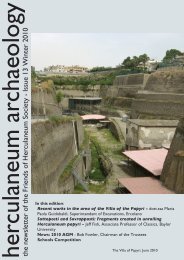herculaneum archaeology - The Friends of Herculaneum Society
herculaneum archaeology - The Friends of Herculaneum Society
herculaneum archaeology - The Friends of Herculaneum Society
Create successful ePaper yourself
Turn your PDF publications into a flip-book with our unique Google optimized e-Paper software.
<strong>The</strong> Third <strong>Herculaneum</strong><br />
Conference<br />
Robert Fowler<br />
<strong>The</strong> <strong>Friends</strong> met 11–13 June for their third gathering in<br />
Campania since 2006, in what is now an established biennial<br />
tradition. For repeat attenders it felt like a reunion, while at<br />
the same time it was gratifying to welcome a good number <strong>of</strong><br />
newcomers. For the first two meetings we resided in Naples<br />
(hence the First and Second ‘Naples’ Congresses), but for<br />
this one we moved out to Ercolano itself, a prospect made<br />
enticing by the opening <strong>of</strong> the four-star Miglio D’Oro hotel,<br />
a spectacular, done-over 18th-century villa which made up<br />
in atmosphere—especially the garden—what it (so far)<br />
lacks in abundance <strong>of</strong> staff (in some areas). <strong>The</strong> experiment<br />
was judged successful both for its convenience and for the<br />
benefit we were able to deliver to the local economy, not<br />
just the Miglio D’Oro but to B&Bs and local businesses. It<br />
was a pleasure to have time to explore the town, and see the<br />
extraordinary collection <strong>of</strong> early modern villas. <strong>The</strong> potential<br />
<strong>of</strong> Ercolano is quite immeasurable.<br />
Prior to the formal opening there was an opportunity<br />
Friday afternoon to see the latest work <strong>of</strong> the <strong>Herculaneum</strong><br />
Conservation Project. <strong>The</strong> first highlight was the splendid<br />
multi-story south wing <strong>of</strong> the House <strong>of</strong> the Relief <strong>of</strong> Telephus,<br />
(see front cover) adjacent to the Suburban Baths, where<br />
excavation and cleaning have brought to light evidence <strong>of</strong> the<br />
effects <strong>of</strong> bradyseism preceding the major eruption <strong>of</strong> AD 79.<br />
<strong>The</strong> encroaching sea obliged the ancient occupants to erect<br />
sea-walls and abandon ground floors, which were filled in.<br />
Excavation also established that the tuff first laid down by an<br />
eruption 8,000 years ago was mined for building materials at<br />
all stages <strong>of</strong> the town’s existence. At the top <strong>of</strong> the building,<br />
an ingenious solution to a tricky conservation problem was<br />
found in ‘medium-term ro<strong>of</strong>ing’: the ro<strong>of</strong> needed to last<br />
beyond the short-term, but anything dubbed ‘long-term’<br />
would have to negotiate various planning obstacles and satisfy<br />
several interest groups. <strong>The</strong> design and engineering <strong>of</strong> the<br />
protective covering is a model for conservation elsewhere.<br />
Also on the agenda for Friday afternoon was a tour <strong>of</strong> the<br />
2<br />
1. <strong>The</strong> Gardens <strong>of</strong> the Miglio d’Oro<br />
Suburban Baths, not normally open to the public, and a<br />
peak inside the Bourbon tunnels in the Basilica—this was<br />
a particular treat, as one could see some quite breathtaking<br />
original frescoes in situ, untouched by any restoration. <strong>The</strong><br />
narrow space could accommodate only three or four tightly<br />
squeezed people at a time.<br />
2. 3. 4. <strong>The</strong> Suburban Baths<br />
5. Waiting to see frescoes in a<br />
Bourbon tunnel in the Basilica



